Lake Bonney Expedition 2008
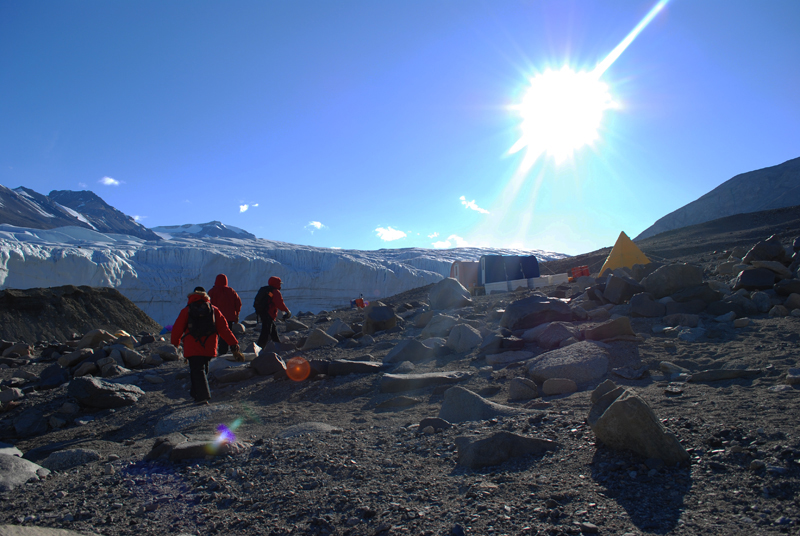
The first deployment is under way.
Here are the first week's blog entries from Vickie Siegel.
For the most recent entries see the bonney 08
blog
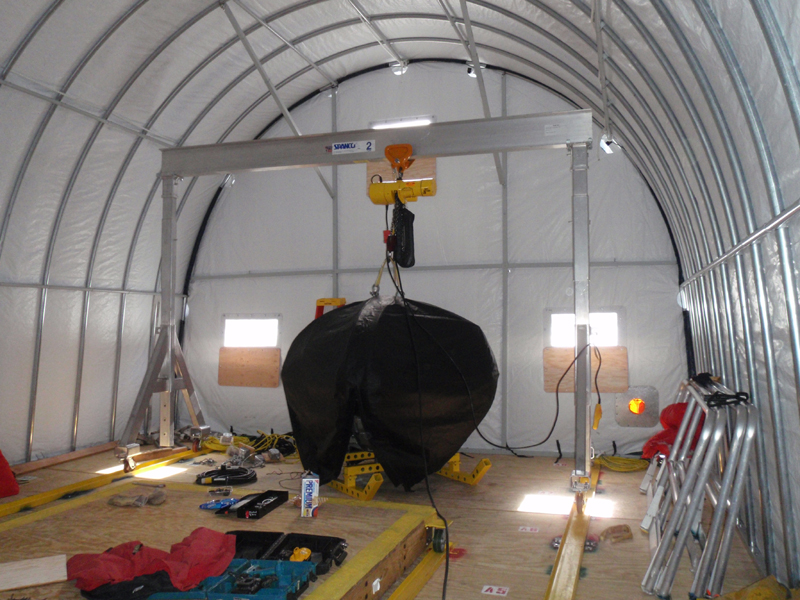
The gantry and hoist are set up inside our completed tent
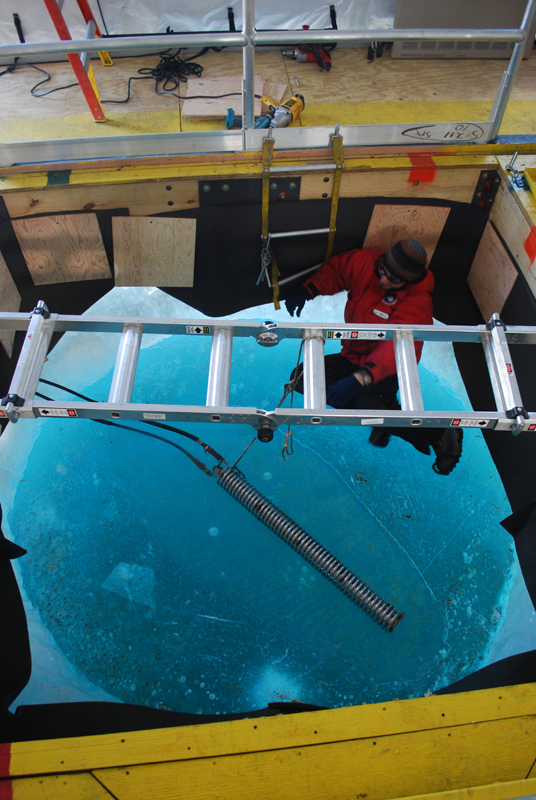
Maciek starts the melting coil on the refrozen cap on our melt hole. The steam generated from this made the Bot House into a sauna for a few minutes
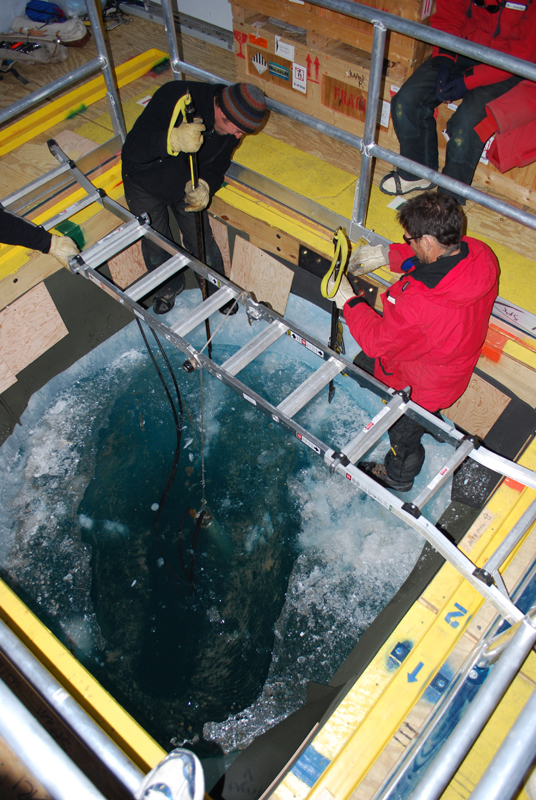
Once the melter punched through the frozen cap, Maciek and John worked on chipping out some of the ice around the sides of the hole
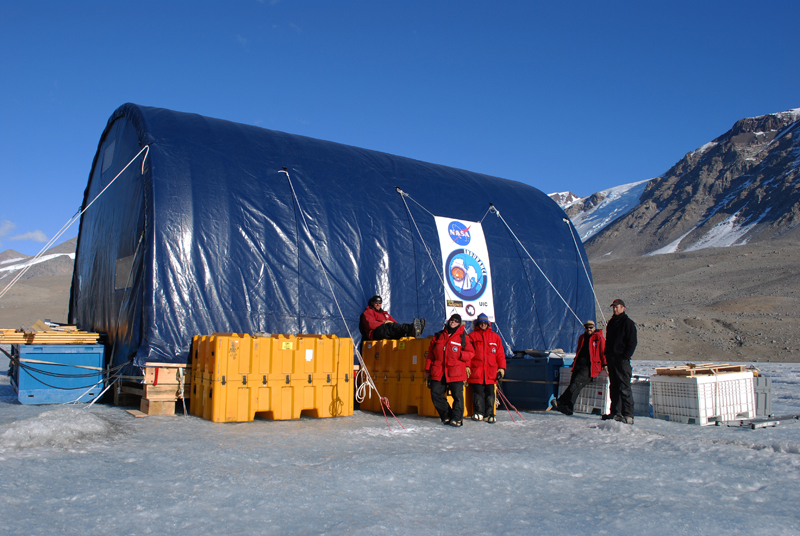
The Bot House is open for business! Bob, Vickie, Shilpa, Bart and Peter (left to right) pose in front of the haven

The commute back home after a satisfying day
Tuesday
December 2, 2008
What a difference a day makes. Kristof was the
first one
up and about this morning and he immediately set out on a
mission. He drove the ATV from our somewhat sheltered camp on the
shore to our Bot House site on the ice. After a brief stop at the
platform to assess the situation, he returned to camp directly to
report his findings. The rest of us awoke to the sound of two
cooking pots banging together and Kristof shouting, “Everybody
up! The wind has died down! Let’s get to work!”
We were all still exhausted from our efforts yesterday but this news
rousted us from our sleeping bags. As we hurriedly ate our
breakfasts and gulped down some of Bob’s coffee we wondered, “Can we do
it? Can we get the rest of the tent up before the wind kicks in
again?”
We marched out to the melt hole and found that yes, it was much calmer
out there. But was it enough? With trepidation unpacked the
liner tarp and once again we tied on the ropes and tossed them over the
frame. With the first few tugs on the ropes we found that things
really were much easier. We had the liner tarp up and secured and
the end walls in place in no time. We had just started to pull
the middle insulating layers onto the tent when a helo carrying our
carpenter friends from McMurdo arrived to help us. From there on
out the Bot House was abuzz with productivity. It was difficult
to even keep track of all the activities that were happening
simultaneously — the insulating blankets and outer cover were pulled
over
the tent and secured, inside, the bot’s lifting gantry and hoist were
assembled, electrical outlets were installed, heaters were brought in
and propane tanks were staged outside, generators were set up,
communications technicians arrived and set us up with solar powered
wireless internet, the crust of ice that had refrozen on the surface of
the hole was melted and chipped out, stairs up to the front door were
installed, shipping containers full of our equipment were sorted and
the contents brought inside, and finally the shipping containers
themselves were pulled in close against the outside walls and secured
with cargo straps to ensure that nothing could blow away.
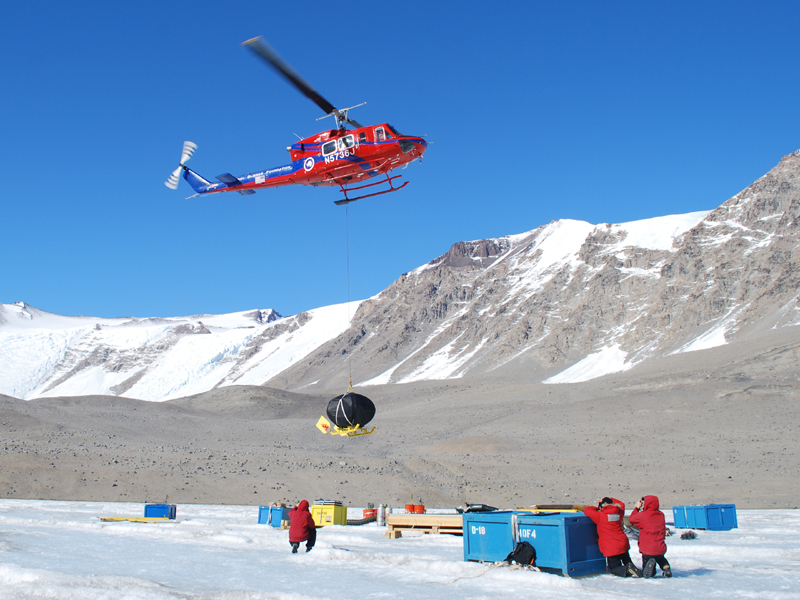
We look on nervously as the helo lowers the bot onto our Bot House platform
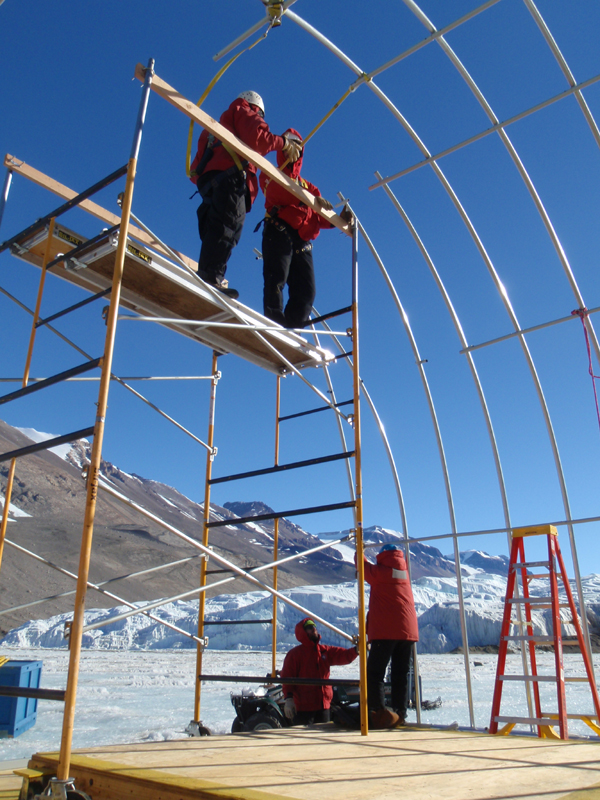
Members of the team work together to construct the final pipe arches (there are 17 total) of the tent frame
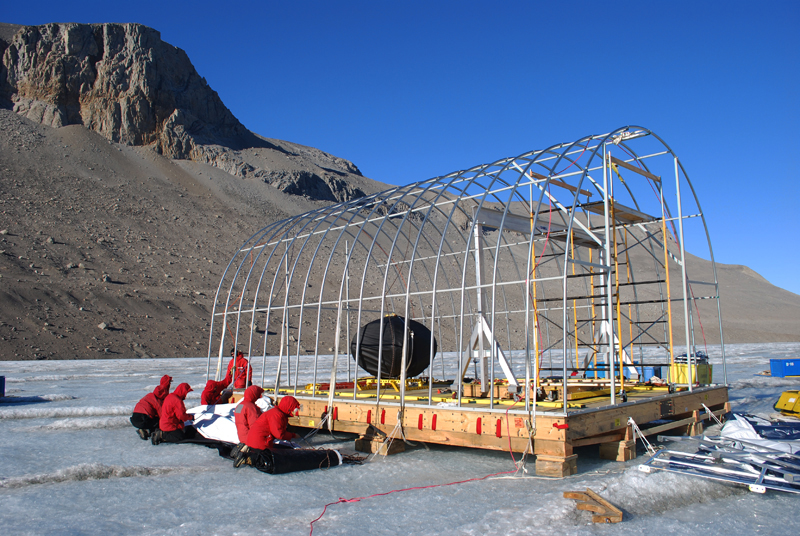
With the frame completed we begin to unroll the liner tarp on the up wind side of the structure. We plan to tie ropes to one edge and pull it over the frame to tie off on the downwind side
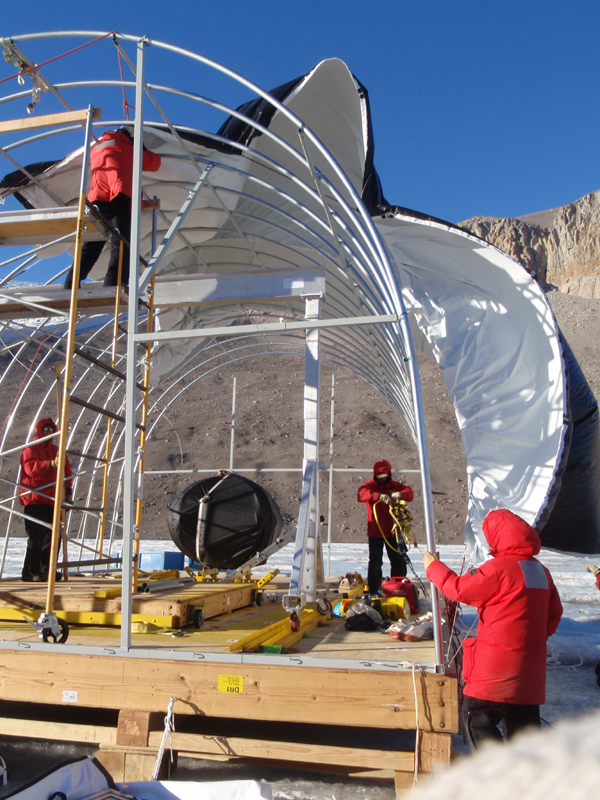
This quick photo, the only one snapped during our epic battle, does little to convey the chaos of the gusting wind and the tarp that threatened to carry us all away
Monday
December 1, 2008
In accordance with our hopes, the winds died down
enough by this
morning that helos were flying today. In addition to the
much-anticipated delivery of the bot we were expecting several other
sling loads, include the final bits of plywood for the bot house floor
and the roll-away cover for the melt hole, now referred to as the moon
pool. These items arrived first thing in the morning and we
wasted no time getting everything in place. The next sling load
to come over the horizon was a black oval with yellow feet and
flame-decaled yellow fins. Everyone scurried to pull out their
cameras and hunker down behind the various large shipping crates that
are scattered around the platform. With a 2000 lb sling load a
212 helo creates a tremendous amount of rotor wash and certainly a lot
of noise. The physical turbulence made the emotional rush of
seeing the pilot set the bot squarely down on the platform all the more
exhilarating. The pilot unclipped the cable and thundered
off. Now it was time to get to work.
The next step on our agenda was to build the polar haven tent structure
of the Bot House around the bot. We learned the procedure in
McMurdo: assemble the pipe arches and walls that make up the
frame of the haven, pull the insulated blankets (tarps) on the end
walls, pull liner a tarp over the arches and tie it down to the floor
on either side, on top of this go insulating layers over the arches and
then finally a large, weather resistant cover goes over it all. Our
entire practice run in McMurdo took 6 hours.
Things started off well enough. Though it was slightly breezy, we
made quick process in constructing the pipe frame. Two people
worked from the top of some scaffolding and the rest scrambled around
arranging pipes and fitting them together. Over the course of the
afternoon the wind began to build but in our concern to get a shelter
built over the bot we didn’t take much notice - yet. Once the
frame was together we pulled out the liner tarp and prepared to install
it on the 16’ tall frame. We lined the tarp up on the ground
along one side of the arches and tied ropes to one edge of the
fabric. Then we threw the other end of each rope over the entire
frame to people standing on the other side of the structure. Half
of the team pulls the ropes to drag the tarp up and over the arches
while the other half feeds the tarp up and manages any snags that
occur. This is when we really noticed the wind. We were
trying to pull the tarp from the upwind side of the structure to the
downwind but the force from the wind meant that the tarp simply pressed
against the pipe frame with enough pressure that it was incredibly
difficult to drag it up to the peak and over. Once we did get it
over the top, everything got worse. With no wall to press into,
the downwind end of the tarp whipped up violently against the 4 ropes
we had tied to it. It became a sail. Helpers jumped in to
assist the rope haulers, who were nearly being whisked away on the ends
of their ropes. The points where we had tied the ropes on the
tarp began to rip through, giving the raging beast a greater range for
its erratic motions. With the whipping and cracking of the
tarp, the gusting wind, and our layers of hats and hoods, shouts and
instructions were snuffed out. This was the stuff of epic sea
chanteys, not field robotics. Somehow we managed to tie down, at
least marginally, both sides of the tarp. Worried that the liner
tarp would rip further unless we put up the end wall tarps quickly, we
plunged into this next struggle. By now we had been working on
the tent for about 8 hours. After some time spent fighting more
of the same battle with the first end wall, Peter made the call that we
were in a losing battle, the wind was just too strong. The rest
wearily agreed and after the equally arduous task of removing the tarps
from the frame and corralling the unruly masses of fabric back into
boxes for the night we dragged ourselves back to camp. Sometimes
it’s just best to try again tomorrow.

This diagram by Hannes Grobe was copied from the Wikipedia page on katabatic wind.
Sunday
November 30, 2008
Since our next moves can only happen after the bot
is delivered
tomorrow, today was a natural day to just take a break. The winds
continued to barrel down the valley but some folks decided to take the
free time as a chance to do some hiking anyhow. The others caught
up on office work, read books and drank cocoa. Around the dinner
table Peter explained the origins of the incredible wind we’ve been
experiencing. The Antarctic continent is shaped like a giant
dome, more or less. The land in the interior of the continent is
covered with a massive ice sheet over two kilometers thick and the
highest elevation of this dome is around the center of the
continent. During the winter the rock and ice radiate their heat
out to space and temperature drops. As the land cools, the air
does, too. The air grows denser as it cools and gravity starts to
drive it downhill. The phenomenon is called a katabatic wind and
in Antarctica they are known to be fierce, cold and persistent.
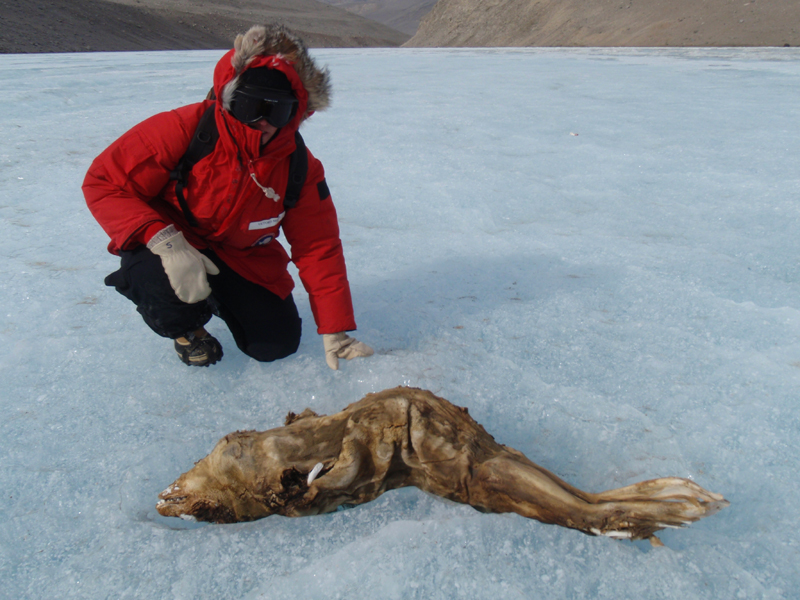
Hiking from Blood Falls Camp to Lake Bonney camp, Vickie and Bill found several mummified seals on the ice
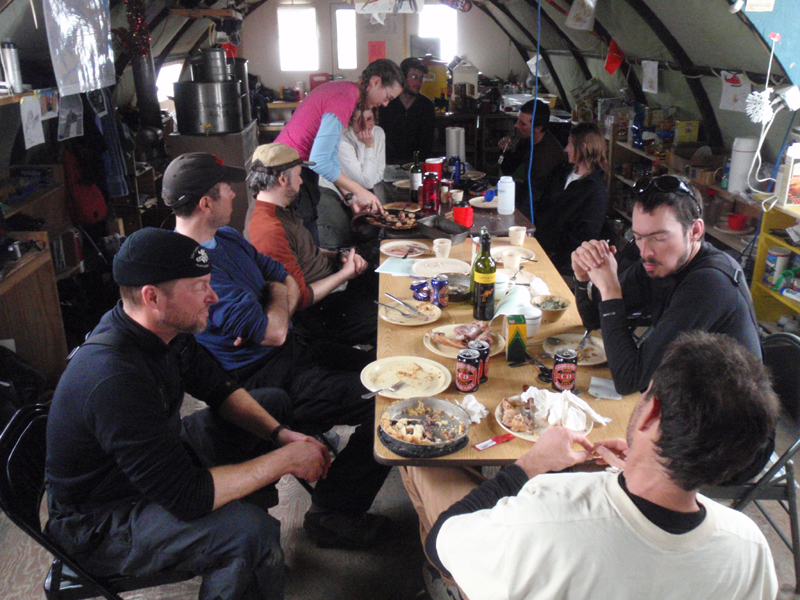
Everyone relaxes after Thanksgiving dinner in the Lake Bonney jamesway
Saturday
November 29, 2008
In US Antarctic Program tradition, Thanksgiving is
celebrated
the
Saturday after the actual holiday so that everyone gets a long weekend,
both Saturday and Sunday off work! Of course, we are hardly the
sort
of people to argue with that kind of a tradition and we had an
invitation from John and the folks at the Lake Bonney camp to join them
for turkey dinner. Around midday we headed over to the camp on
the
east lobe of Lake Bonney. Most folks opted for the 20 minute ATV
ride
to the camp and Bill and Vickie decided to walk. Along the way
they
came across several mummified seals. For unknown reasons, seals
and
penguins occasionally wander away from the sea and travel up the Dry
Valleys. A long way from home and with no chance of finding food
in
the barren valleys, these animals die before finding their way
back.
Since there are no insects to consume them and the climate is extremely
dry and cold, the corpses remain remarkably intact for years.
The last stragglers arrived at Lake Bonney Camp just as the turkeys
were coming out of the oven. Noshing away on our stuffing and
sweet
potatoes we admired our surroundings. Unlike our camp at Blood
Falls,
the Lake Bonney is a permanent installation that is used every
season.
It is larger than our camp, with several large tents in addition to
personal sleeping tents and a 15’ x 40’ Jamesway building which is the
kitchen and community space for the group there. Also they have
WiFi.
It was field camp nirvana. After thoroughly enjoying the good
food and
good company provided by the Bonney Camp researchers we took ATVs back
to Blood Falls for the night.
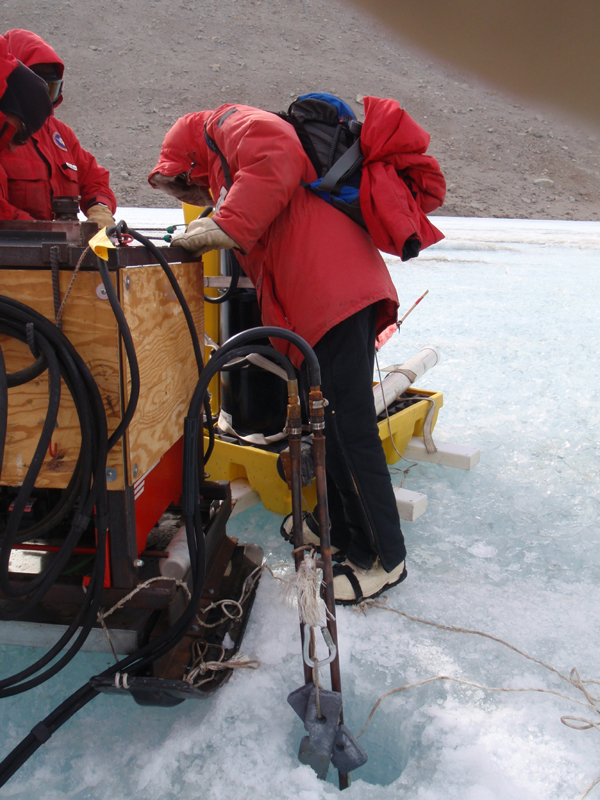
The trombone melter in the pilot hole we drilled.
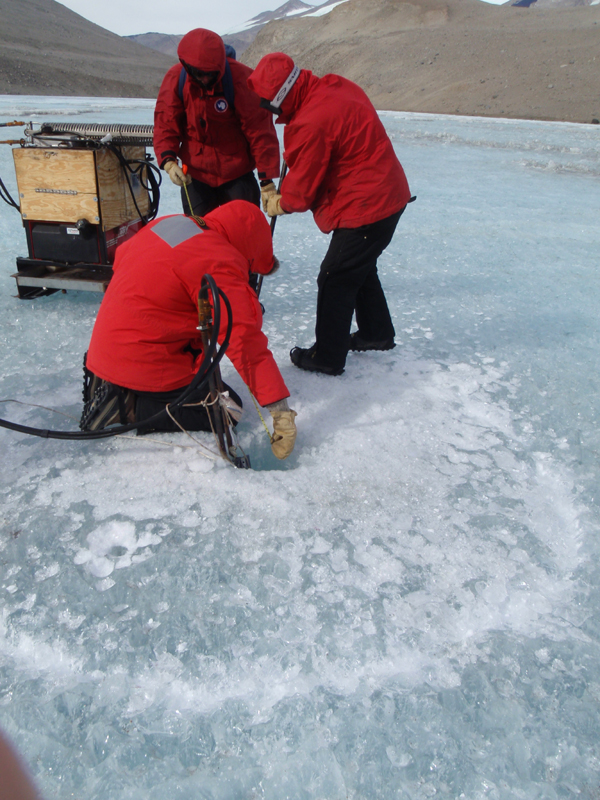
Peter, Bill and Maciek mark the perimeter of the 8’ diameter hole we will melt out.
Friday
November 28, 2008
Things have been going very well with our field
work for the
last two
days—the weather has been pleasant, we made good progress on the Bot
House platform and we’ve even had some tasty camp dinners in our mess
tent. One could almost forget we’re in Antarctica… Well,
today we got a little reminder. Late last night several of us
woke up to find the walls of our tents whipping and popping in our
faces, straining against the tent poles. The mild wind from
yesterday has built up into violent gusts and from what we hear on the
VHF radio, the weather in McMurdo is deteriorating, too. As a
result, no helos are flying today and the official operations in
McMurdo, helo and otherwise, will be shut down Saturday and Sunday for
the Thanksgiving holiday. After all our rush, the bot won’t be
delivered until Monday.
Of course in the field there is always work that needs to be done so we
used our new-found free time to work on mission planning and choose the
spot for our second melt hole. Lake Bonney lies in the bottom of
the Taylor Valley and the lake’s shape is dictated by the valley
walls. It is narrow and long, too long for us to drive the
vehicle to all points in the west lobe of the lake from a single point
so we will work from two different ice holes — one close to the Taylor
Glacier face and the second further east. About halfway through
our field work schedule we will move the bot house to the second hole
but first we need to make the hole.
To initiate us as true scientists in the Dry Valleys, Peter decided
that we needed to drill the pilot hole in the ice. Annika was our
designated “drill sergeant” and showed us how to operate the Jiffy
drill, a machine that requires two people and a drill bit 10 inches in
diameter. After we drilled the hole, Peter, Maciek and John
Priscu returned and helped us place a melter in our pilot hole.
Someone has to return to refuel the generator here every 4 or 5 hours
and in two days we should have another 8’ hole in the ice.
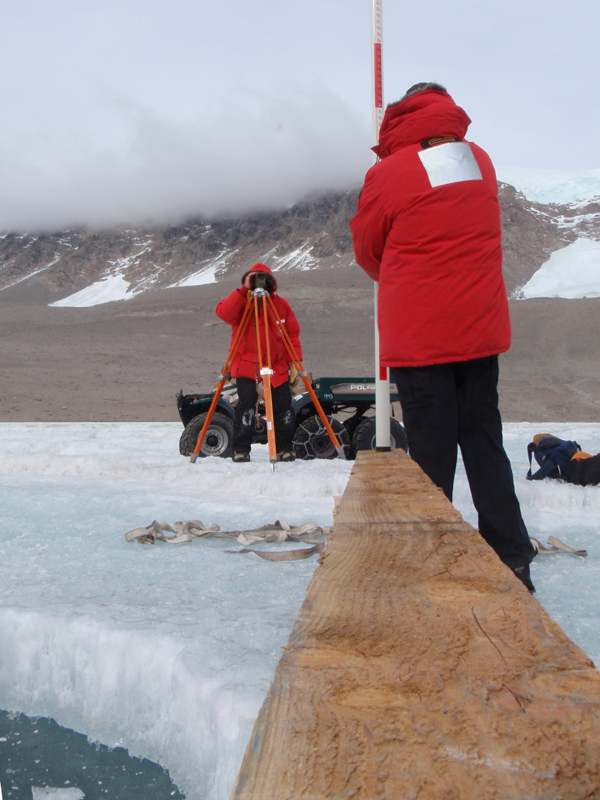
Peter and Bill level the timbers.
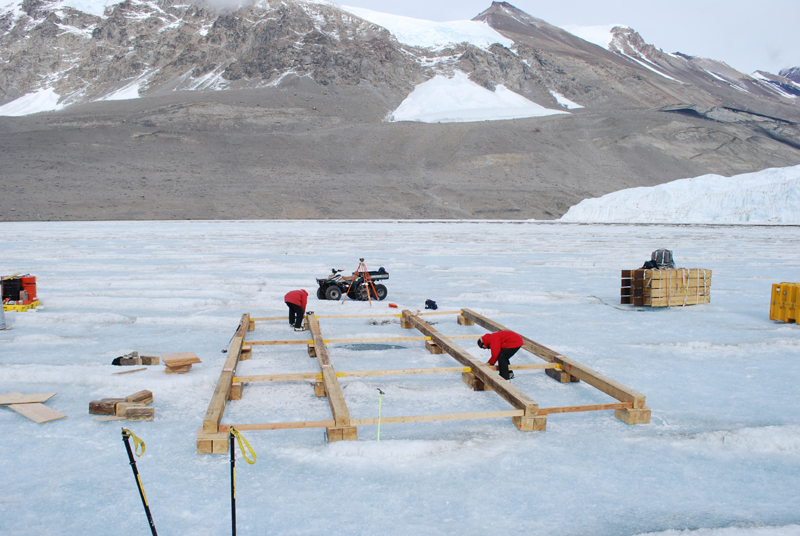
The 8x8 timbers are in place and ready for the floor panels

Moving the floor panels with the ATV was much easier than lifting them
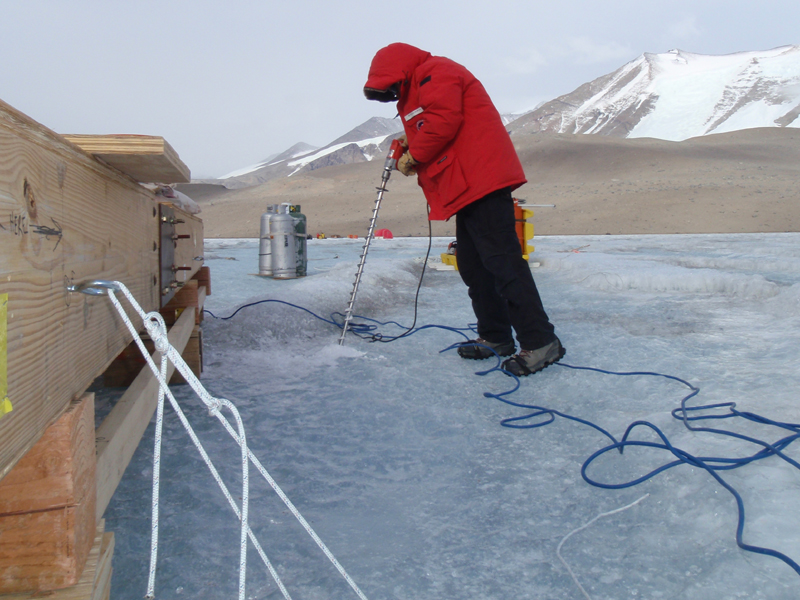
Peter drills holes in the ice to anchor the platform
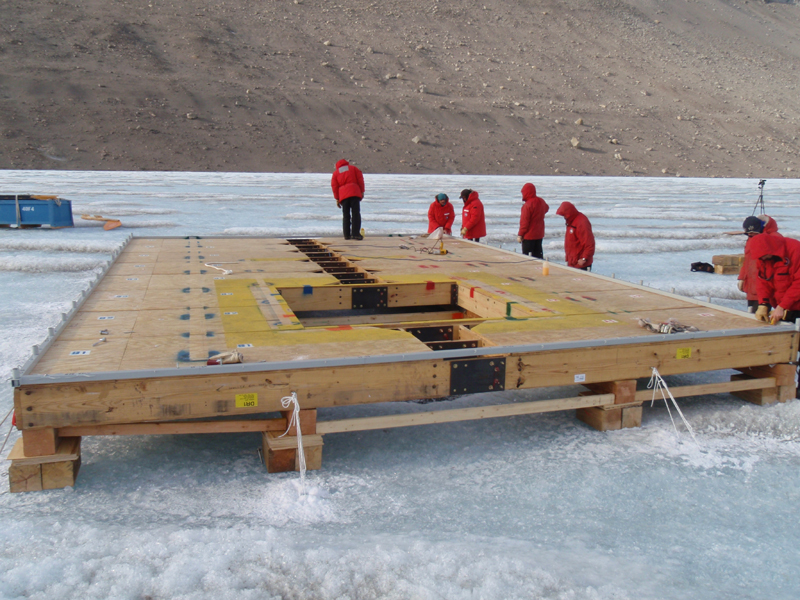
A completed floor at the end of the day
Thursday
November 27, 2008
We returned to the floor supports we placed
yesterday. To
ensure
that our finished floor sits level, Bill and Peter took some time to
measure the height of each floor support as the others placed the 8”x8”
timbers that hold the floor panels. With their measurements, we
shimmed some of the timbers with plywood to bring them to the proper
height. The 8x8’s are held in place end to end by steel moment
plates. We attached these and then added 2x4 spacers that keep
the four rows of 8x8’s parallel.
With the 8x8 timbers in place, our next move was to start placing floor
panels. During our test-build of the Bot House in McMurdo, we
learned that the floor panels are heavy (~500 lbs), but manageable when
many people work together to lift them. The difference between
our test build and the real thing, however, is that here we are working
on the uneven and slick surface of the lake ice instead of the flat
gravel yard at McMurdo. Slowly and cautiously, we inched the
first few platform sections across the ice until Maciek brought our
attention to another tool we have at our disposal here: the
ATV. The new procedure became to have several lifters carefully
place a platform section onto the bed of the ATV and then walk
alongside the vehicle to make sure it didn’t slide off the bed as
someone drove the ATV to the platform - in - construction. From there
it was easy to transfer the section from the ATV to the 8x8’s.
As one crew moved the floor sections into place, other folks worked to
line the panels up and bolt them to each other. Then the floor
sections needed to be anchored to the ice. For this Peter drilled
2 holes into the ice at the end of each panel. The holes
intersected under the surface in a V - configuration. We threaded
rope through the ice holes and tied off to eye bolts in the sides of
panels. The finishing touch for the day was to secure the base
frame of the tent to the edge of the floor.
We are ready to build the tent after the bot arrives tomorrow!
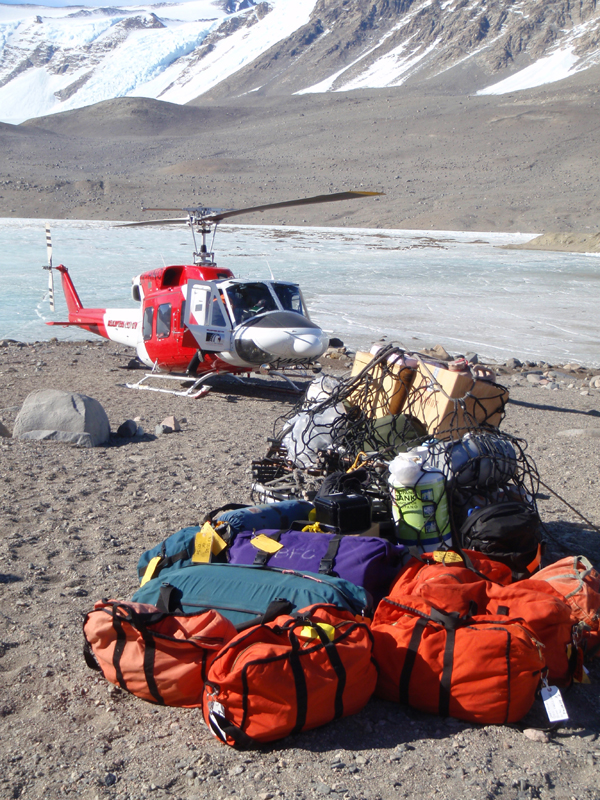
A sling load and our duffel bags on the shore of Lake Bonney, at Blood Falls Camp
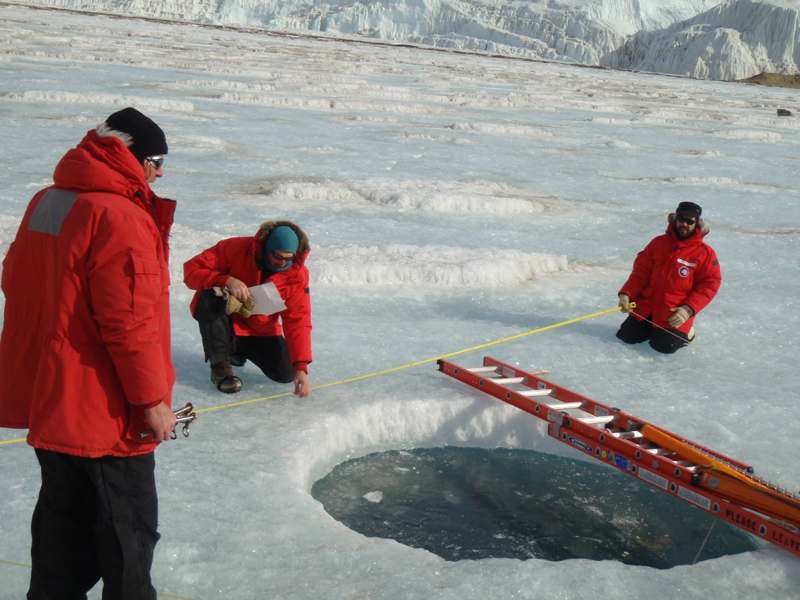
Bob, Bill and Bart decide where to place the floor supports around our ice hole. A couple inches of ice have refrozen on the water surface, making it safer for us to work around the hole
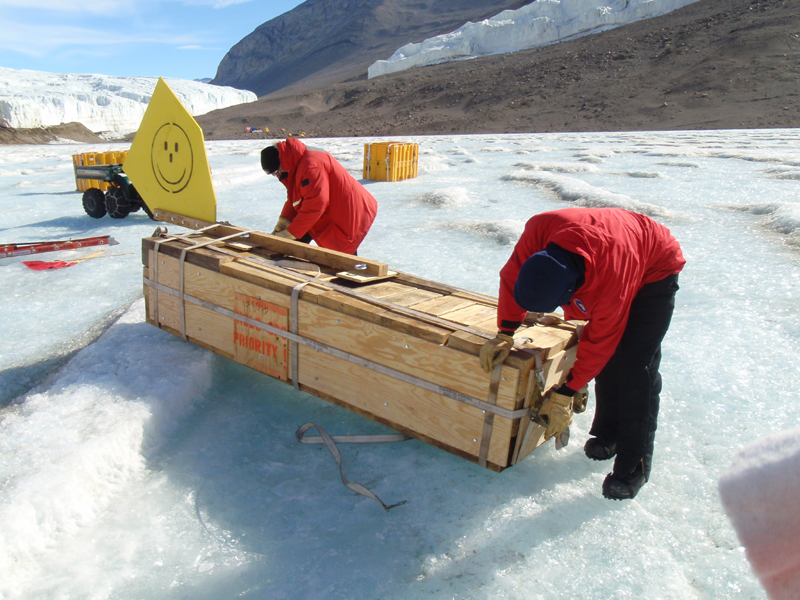
Bob and Kristof unwrap a lumber sling load on the lake ice. The yellow wings are placed on the sling loads by the helo techs to stop the load from spinning as the helicopter flies through the air.
Wednesday
November 26, 2008
Our first day in the field! This morning we started
off by
enjoying our
last prepared breakfast in the McMurdo Station dining hall and then
checked out of our rooms and headed down to the helo pad for our flight
to the west lobe of Lake Bonney. The plan was that Peter, Bill,
Kristof, Bob, Annika, Maciek and Vickie would head out to the Blood
Falls campsite and start to set up the Bot House platform on the lake
ice. Chris and Shilpa would join us in the field on Friday. Maciek and
Annika left town on the first flight to run some errands at the Lake
Bonney camp before the rest of us arrived. After we selected our
helmets and weighed ourselves, the helo technicians loaded our duffel
bags into the Huey and we all squished into the remaining seats. The
rhythmic thud of the rotors accelerated and we were carried over the
white expanse of the Ross Ice Shelf and into the stark grey granite
walls of the Taylor Valley.
After the scenic 40 minute flight we arrived at the Blood Falls Camp
site, named for the dark orange streaks in the iron stained glacier
nearby. McMurdo carpenters had already set up two small weather haven
tents for us and a couple helo sling loads of our camp gear had already
been delivered that morning. We took a couple of hours to set up camp.
We decided to use the smaller weather haven as a kitchen and the larger
red haven as a dining room. We set up our tables and chairs, moved food
into the kitchen and set up our personal tents.
After a quick lunch we
walked out to the 8’ diameter ice hole that Maciek and Annika melted
for us last week. For a quarter mile radius around the hole, the ice
was strewn with sling loads of our gear—lumber, tools, drums of fuel,
and the wood panels that will make up the floor of our Bot House. The
first task was to unload some of the tool boxes and lumber pallets.
Once we had some tape measures in hand we were ready to start real work
towards building the platform. Over the course of the afternoon we
surveyed out the locations for the floor supports, stopping
occasionally to duck low when additional helo deliveries arrived. By
evening all of the floor supports were in place. The last sling load
was set on the ice just as we all crawled into our tents for the night.




